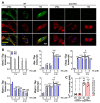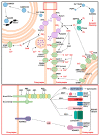Mouse Ataxin-2 Expansion Downregulates CamKII and Other Calcium Signaling Factors, Impairing Granule-Purkinje Neuron Synaptic Strength
- PMID: 32932600
- PMCID: PMC7555182
- DOI: 10.3390/ijms21186673
Mouse Ataxin-2 Expansion Downregulates CamKII and Other Calcium Signaling Factors, Impairing Granule-Purkinje Neuron Synaptic Strength
Abstract
Spinocerebellar ataxia type 2 (SCA2) is caused by polyglutamine expansion in Ataxin-2 (ATXN2). This factor binds RNA/proteins to modify metabolism after stress, and to control calcium (Ca2+) homeostasis after stimuli. Cerebellar ataxias and corticospinal motor neuron degeneration are determined by gain/loss in ATXN2 function, so we aimed to identify key molecules in this atrophic process, as potential disease progression markers. Our Atxn2-CAG100-Knock-In mouse faithfully models features observed in patients at pre-onset, early and terminal stages. Here, its cerebellar global RNA profiling revealed downregulation of signaling cascades to precede motor deficits. Validation work at mRNA/protein level defined alterations that were independent of constant physiological ATXN2 functions, but specific for RNA/aggregation toxicity, and progressive across the short lifespan. The earliest changes were detected at three months among Ca2+ channels/transporters (Itpr1, Ryr3, Atp2a2, Atp2a3, Trpc3), IP3 metabolism (Plcg1, Inpp5a, Itpka), and Ca2+-Calmodulin dependent kinases (Camk2a, Camk4). CaMKIV-Sam68 control over alternative splicing of Nrxn1, an adhesion component of glutamatergic synapses between granule and Purkinje neurons, was found to be affected. Systematic screening of pre/post-synapse components, with dendrite morphology assessment, suggested early impairment of CamKIIα abundance together with the weakening of parallel fiber connectivity. These data reveal molecular changes due to ATXN2 pathology, primarily impacting excitability and communication.
Keywords: K-homology RNA-binding domain; amyotrophic lateral sclerosis (ALS); fragile-X-associated tremor-ataxia syndrome; fronto-temporal-lobar-dementia; inositol signaling; long-term potentiation; neurexin; spatial learning; synaptic plasticity; tauopathies.
Conflict of interest statement
The authors declare no conflict of interest.
Figures








Similar articles
-
Atxn2 Knockout and CAG42-Knock-in Cerebellum Shows Similarly Dysregulated Expression in Calcium Homeostasis Pathway.Cerebellum. 2017 Feb;16(1):68-81. doi: 10.1007/s12311-016-0762-4. Cerebellum. 2017. PMID: 26868665 Free PMC article.
-
Generation of an Atxn2-CAG100 knock-in mouse reveals N-acetylaspartate production deficit due to early Nat8l dysregulation.Neurobiol Dis. 2019 Dec;132:104559. doi: 10.1016/j.nbd.2019.104559. Epub 2019 Jul 31. Neurobiol Dis. 2019. PMID: 31376479
-
Ataxin-2 regulates RGS8 translation in a new BAC-SCA2 transgenic mouse model.PLoS Genet. 2015 Apr 22;11(4):e1005182. doi: 10.1371/journal.pgen.1005182. eCollection 2015 Apr. PLoS Genet. 2015. PMID: 25902068 Free PMC article.
-
Electrophysiological Studies Support Utility of Positive Modulators of SK Channels for the Treatment of Spinocerebellar Ataxia Type 2.Cerebellum. 2022 Oct;21(5):742-749. doi: 10.1007/s12311-021-01349-1. Epub 2022 Jan 3. Cerebellum. 2022. PMID: 34978024 Review.
-
Spinocerebellar Ataxia Type 2.Adv Exp Med Biol. 2018;1049:175-195. doi: 10.1007/978-3-319-71779-1_8. Adv Exp Med Biol. 2018. PMID: 29427103 Review.
Cited by
-
Synaptic dysfunction in ALS and FTD: anatomical and molecular changes provide insights into mechanisms of disease.Front Mol Neurosci. 2022 Oct 3;15:1000183. doi: 10.3389/fnmol.2022.1000183. eCollection 2022. Front Mol Neurosci. 2022. PMID: 36263379 Free PMC article. Review.
-
Emerging biomarkers in amyotrophic lateral sclerosis: from pathogenesis to clinical applications.Front Mol Biosci. 2025 Jun 30;12:1608853. doi: 10.3389/fmolb.2025.1608853. eCollection 2025. Front Mol Biosci. 2025. PMID: 40661315 Free PMC article. Review.
-
Candidate SNP Markers Significantly Altering the Affinity of the TATA-Binding Protein for the Promoters of Human Genes Associated with Primary Open-Angle Glaucoma.Int J Mol Sci. 2024 Nov 28;25(23):12802. doi: 10.3390/ijms252312802. Int J Mol Sci. 2024. PMID: 39684516 Free PMC article.
-
In Cerebellar Atrophy of 12-Month-Old ATM-Null Mice, Transcriptome Upregulations Concern Most Neurotransmission and Neuropeptide Pathways, While Downregulations Affect Prominently Itpr1, Usp2 and Non-Coding RNA.Cells. 2023 Oct 3;12(19):2399. doi: 10.3390/cells12192399. Cells. 2023. PMID: 37830614 Free PMC article.
-
Ataxin-2 polyglutamine expansions aberrantly sequester TDP-43 ribonucleoprotein condensates disrupting mRNA transport and local translation in neurons.Dev Cell. 2025 Jan 20;60(2):253-269.e5. doi: 10.1016/j.devcel.2024.09.023. Epub 2024 Oct 16. Dev Cell. 2025. PMID: 39419034
References
-
- Pulst S.M., Nechiporuk A., Nechiporuk T., Gispert S., Chen X.N., Lopes-Cendes I., Pearlman S., Starkman S., Orozco-Diaz G., Lunkes A., et al. Moderate expansion of a normally biallelic trinucleotide repeat in spinocerebellar ataxia type 2. Nat. Genet. 1996;14:269–276. doi: 10.1038/ng1196-269. - DOI - PubMed
-
- Sanpei K., Takano H., Igarashi S., Sato T., Oyake M., Sasaki H., Wakisaka A., Tashiro K., Ishida Y., Ikeuchi T., et al. Identification of the spinocerebellar ataxia type 2 gene using a direct identification of repeat expansion and cloning technique, DIRECT. Nat. Genet. 1996;14:277–284. doi: 10.1038/ng1196-277. - DOI - PubMed
-
- Imbert G., Saudou F., Yvert G., Devys D., Trottier Y., Garnier J.M., Weber C., Mandel J.L., Cancel G., Abbas N., et al. Cloning of the gene for spinocerebellar ataxia 2 reveals a locus with high sensitivity to expanded CAG/glutamine repeats. Nat. Genet. 1996;14:285–291. doi: 10.1038/ng1196-285. - DOI - PubMed
-
- Velázquez-Pérez L., Seifried C., Santos-Falcón N., Abele M., Ziemann U., Almaguer L.E., Martínez-Góngora E., Sánchez-Cruz G., Canales N., Pérez-González R., et al. Saccade velocity is controlled by polyglutamine size in spinocerebellar ataxia 2. Ann. Neurol. 2004;56:444–447. doi: 10.1002/ana.20220. - DOI - PubMed
-
- Velázquez-Pérez L., Rodríguez-Labrada R., Canales-Ochoa N., Montero J.M., Sánchez-Cruz G., Aguilera-Rodríguez R., Almaguer-Mederos L.E., Laffita-Mesa J.M. Progression of early features of spinocerebellar ataxia type 2 in individuals at risk: A longitudinal study. Lancet Neurol. 2014;13:482–489. doi: 10.1016/S1474-4422(14)70027-4. - DOI - PubMed
MeSH terms
Substances
LinkOut - more resources
Full Text Sources
Molecular Biology Databases
Research Materials
Miscellaneous

